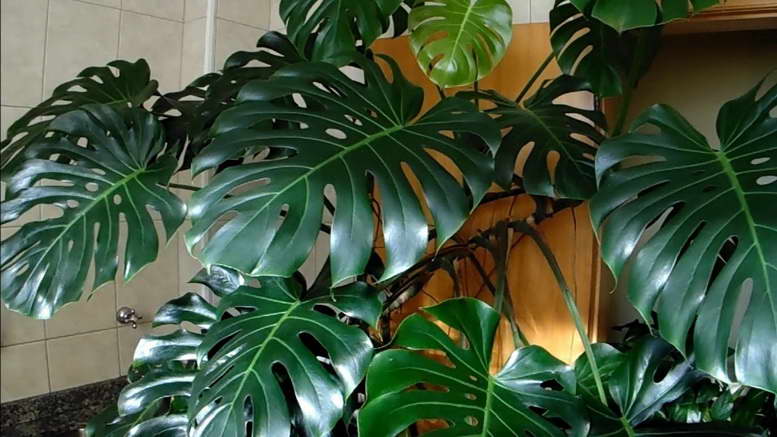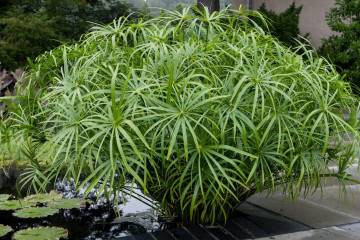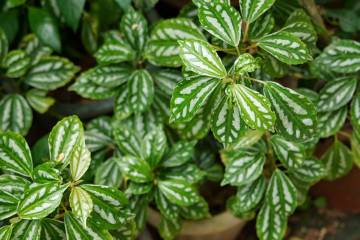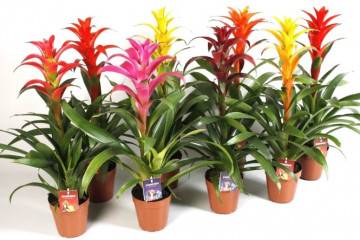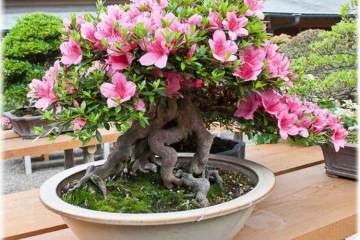Monstera - home care, transplant and reproduction
Content:
Monstera is an ornamental culture that belongs to the Aroid family. Experts in the field of floriculture distinguish about 50 varieties of the plant, which is common in South and Central America.
Monstera - home care
Monstera needs proper care and favorable conditions. To understand how to care for a monster, you need to read the recommendations of specialists. Caring for her is quite simple if you follow all the rules.
Optimal location and lighting
Monstera prefers areas that are brightly lit by the sun's rays. It is best to place flowerpots with it on the windowsills on the east side. When placing the pot on a southern windowsill, it is important to shade it from the sun to prevent burns on the leaf plates. Providing the culture with sufficient light, you can grow bushes with large leaf plates, on which the slots will be clearly visible.
When placing the pot, it should also be borne in mind that the room temperature should be between 24-25 degrees during the warm season and within 18 degrees during the winter months.
Requirements for soil and capacity for planting
To grow young bushes, you need to fill the containers with sod soil, peat, sand and humus. For adult plants, you need to prepare the soil mixture yourself by mixing:
- deciduous soil;
- sod land;
- peat soil;
- a small amount of sand.
When choosing a flower pot, it is important to consider the size of the plant's root system and the desired size of the flower itself. When choosing a large pot filled with loose and fertile soil, you can contribute to the rapid strengthening of the root system in the soil and the active growth of perennials. Better to plant the plants in spacious containers.
Air humidity
Monstera needs an increased level of humidity. In the sultry heat, it is necessary to wipe the sheet plates with a damp sponge every 5-7 hours. This will make it possible not only to moisten the bushes, but also to prevent the invasion of spider mites and scale insects.
Watering and feeding
During the growing season, it is necessary to water the bushes as the topsoil dries out. From the first weeks of autumn, it is worth reducing the frequency of soil moistening procedures, and in winter, water the flowers only after the soil begins to dry to ¼ depth.
Young plants do not need feeding. Adult bushes require fertilization only in the spring months and summer. Organic and mineral fertilizers should be used as top dressing.
Aerial roots and monstera formation
Caring for a monster at home also means carrying out the formation of bushes. Any leaf plate grows thin air roots, which are unacceptable to cut off.The root system is lowered into the container in which the plant grows. This makes it possible to improve the nutrition of the decorative culture. With slow growth of the roots, it is necessary to tie them with moist sphagnum.
Possible problems
Growing a decorative culture at home is interesting, but not so easy. Improper care of the monster can cause various problems.
The most common troubles that await a grower:
- Falling leaf plates, which occurs with poor lighting. The culture in this case throws off the green mass, and the growth rate of the bush slows down significantly.
- The appearance of spots on the leaf plates. Often the cause of spotting on the seamy side of the foliage is the invasion of spider mites.
- Coloration of green mass in brown tones. The problem arises in cases of planting a plant in a too cramped container or with low air humidity.
- Blanching foliage, which can form against a background of too bright lighting.
- Pulling out the bush, which often happens in low light conditions. The shoots become too long and the stems are curled too much. Young foliage is small in size.
- Formation of whole foliage. A lack of nutrients or a lack of lighting affects the shape of the green mass and the presence of cuts.
- Drying foliage. High temperatures and inappropriate levels of air humidity can cause the sheet plates to dry out. An attractive monstera looks terrible at the same time.
- Invasion of harmful insects, namely aphids, spider mites and scale insects.
Caring for a monster flower at home requires strict adherence to the recommendations of specialists. It's important to take care of your green friend to keep them healthy.
Why do monstera leaves turn yellow
The problem of yellowing of green mass most often arises against the background of a deficiency of nutrients in the soil. The leaves also turn yellow due to the fact that liquid begins to stagnate in the substrate and rot appears.
Pests, diseases and treatments
Ornamental culture is susceptible to a number of diseases. Each has its own treatment:
- Fusarium is a fungal infectious disease that occurs against the background of waterlogged soil. The root system of the affected flowers rots, the foliage turns yellow. It is impossible to cure the bushes.
- Late blight is a fungal disease that provokes rotting of the root system and stem. Bushes become infected through water and soil. From the seamy side, the sheet plates are covered with a white bloom. On the outside, markings of a purple-brown hue can be found. It is impossible to cure the affected plants.
- Chlorosis, as evidenced by yellow leaves and their gradual discoloration. In order to cope with the disease, experts recommend treating with Iron Chelate.
- Gray rot, as evidenced by gray spots on bushes and dying spots. The disease is contagious and can in a short period of time affect all flowers growing nearby. During treatment, the diseased plant is placed in a separate room. It is recommended to carry out treatment with a drug like Fitosporin, Trichodermin and Gamair P.
Flowers can be struck not only by diseases, but also by an invasion of pests. The most unpleasant presence:
- Ivy scale, which provokes yellowing of leaf plates, their shedding. To cope with insects, it is recommended to treat the green mass with soap solution and Rogor's solution 0.2%. The humidity level in the room rises.
- A spider mite that settles in the lower part of the foliage and weaves webs. The pest feeds on the sap of the crop, which leads to wilting and drying out. For therapeutic purposes, it is recommended to carry out the treatment with Actellic.
- Aphids, as evidenced by crooked tops, gluten on foliage and the emergence of black fungi. The spread of pests is rapid. The plant needs urgent processing with a decoction of onion and garlic husks.
- Thrips appearing at elevated indoor temperatures. Insects can be found on the seamy side of the leaf plates. Light dots form on top of the thrips. For medicinal purposes, it is worth treating the bushes with insecticidal agents.
- Mealybugs, leading the leaf plates to deformation, drying and falling off. It is important to process the flowers with Actellic as soon as possible.
Reproduction
Reproduction of bushes is a fairly simple process. For this purpose, you can use:
- tops;
- by the seed method;
- by cuttings.
Cuttings
The method is carried out in the spring and summer months. In order to propagate the bushes by this method, it will be necessary to prepare lateral processes, apical cuttings, on which at least one leaf plate must be present. The cut area is treated with a small amount of charcoal powder.
The stalk is planted in a container filled with fertile soil. On the bottom surface, it is necessary to make a drainage layer, which may consist of broken bricks. Having planted the cuttings in the ground, it is necessary to moisten the ground abundantly and cover the container with a piece of glass.
The container is transferred to a room where the temperature reaches 25 degrees. As soon as the root system is formed on the cuttings, they can be cut into separate pots.
Top propagation
The old bush gradually loses its decorative qualities. The lower leaves are flying around. At this time, it is worth wrapping the upper air roots with moist sphagnum and fixing it on the stem.
As soon as the roots have formed their own root system, it is necessary to trim the stem part with a pair of leaf plates and treat the cut zones with a small amount of coal powder. The segments are planted in pots filled with fertile soil. At the same time, old bushes will sprout new shoots and acquire an attractive appearance.
Transfer
To properly transplant a cute "monster", you need to prepare a neutral or slightly acidic substrate with a small amount of peat and sand. Place a drainage layer on the bottom surface of the volumetric container.
The flower is transplanted by the transshipment method. The root system is not cleared of an earthy coma. The most difficult thing is to transplant tall bushes, so flower growers recommend simply pouring some fresh soil into an existing container.
Rejuvenation
Rejuvenation is considered one of the ways of propagation of culture. It is advisable to apply it to old bushes that have lost their decorative characteristics. In April, the upper part of the perennial is cut in such a way that several leaf plates remain on it. The cut part is placed in water until the roots begin to form. Only after the root system fills the entire container with water can a transplant be carried out.
Monstera variegated - home care
The variegated flower is the most beautiful monstera species. Variegated leaf plates contain dark green and white in their color. The variety is quite capricious, so you should not grow it for beginners in the field of floriculture.
The crown of the variegated variety must be in an area with diffused light.A correctly chosen place for placing the pot will allow you to grow a bright variegated plant that can decorate any room.
You can not place the vine in the passages. The temperature regime in the room should reach 24 degrees during the warm season. In winter, the temperature may drop to 19 degrees.
Monstera prefers high humidity. Large sheet plates evaporate a lot of moisture. It is important to systematically wipe the green mass with a damp cloth. It is necessary to moisten the soil every 2 days. Drying out of the soil is unacceptable for this variety.
When growing bushes, it is important to choose the right composition of the soil mixture and in the warm season to add mineral fertilizing and organic matter to the ground. It is advisable to use fertilizers that the manufacturer produces for decorative flowering crops.
Monstera is an amazing plant that grows quickly with proper care and retains its decorative characteristics.

